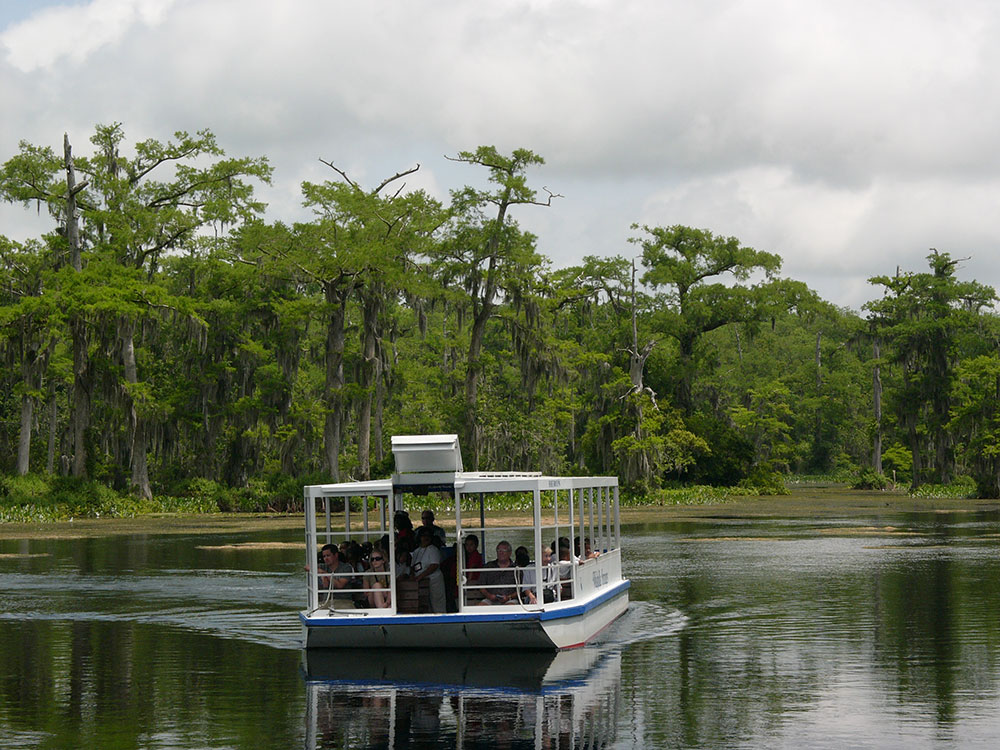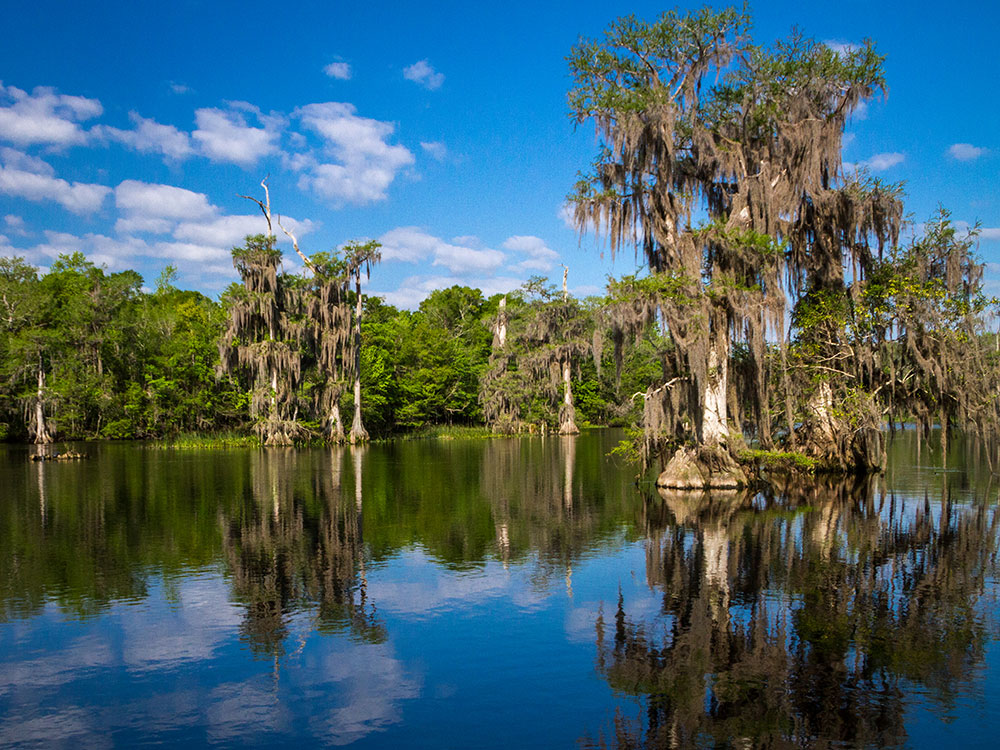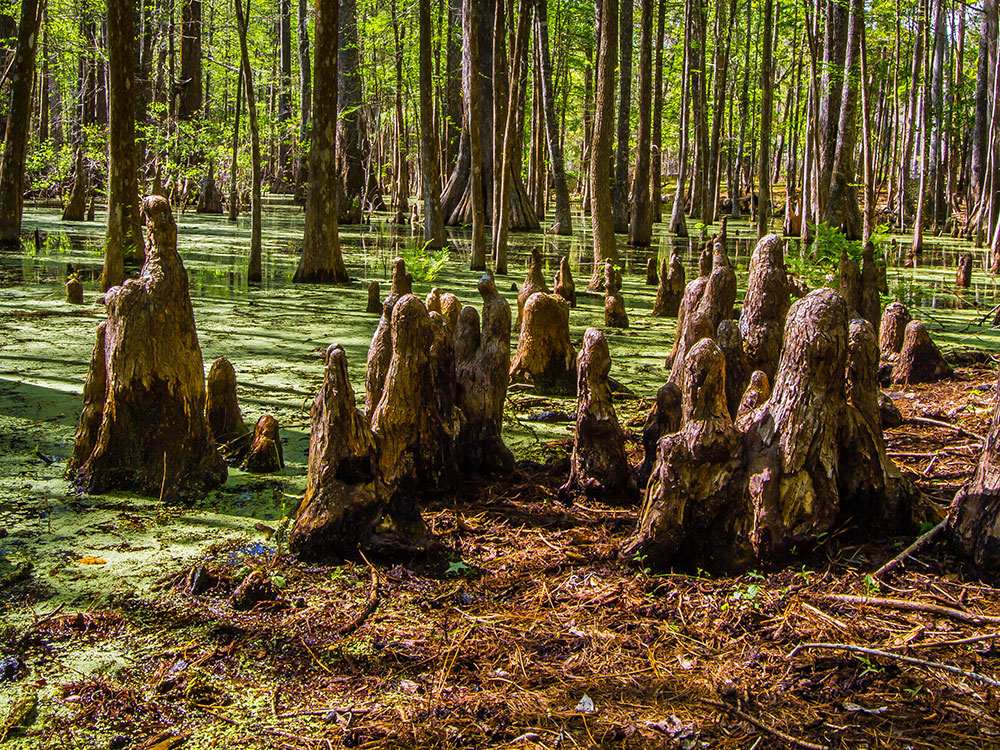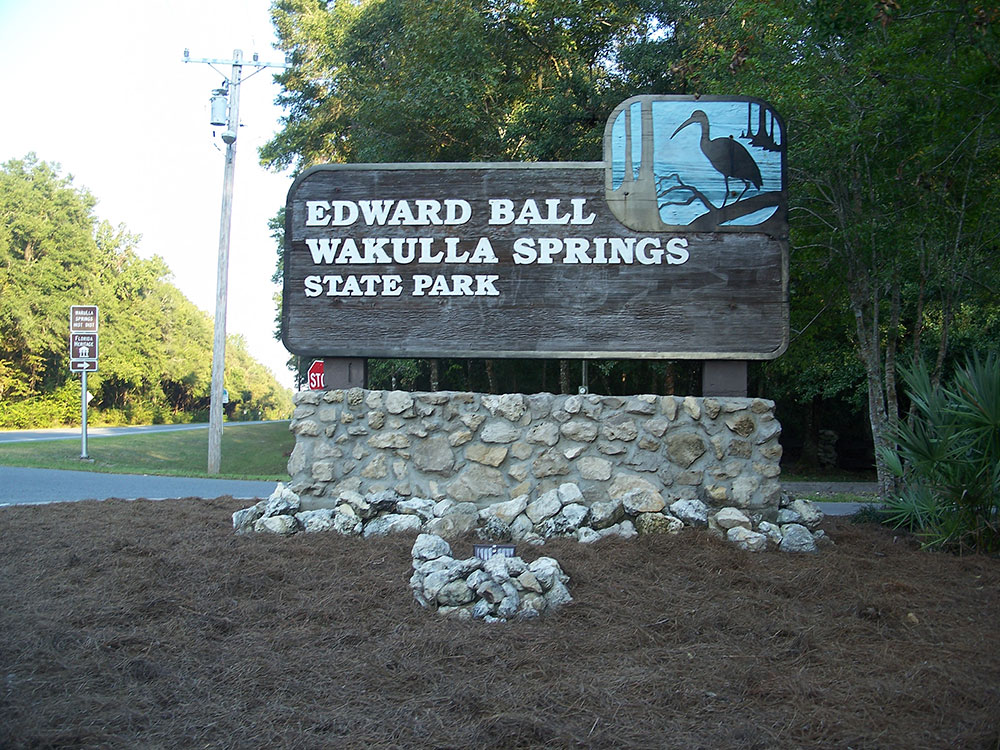General Information
Open 6am to 9pm daily
How to Get There
Wakulla cave is a branching flow-dominated cave that has developed in the Floridan Aquifer under the Woodville Karst Plain of north Florida.
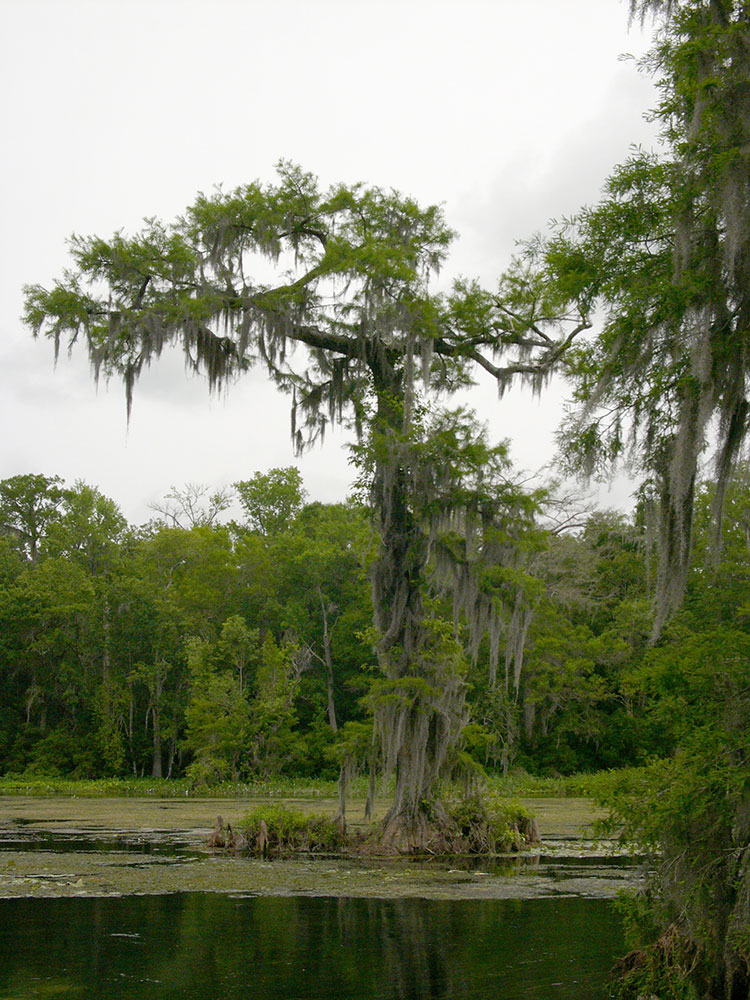
It is classified as a first magnitude spring and a major exposure point for the Floridan Aquifer. The spring forms the Wakulla River which flows 9 miles (14 km) to the southeast where it joins the St. Mark's River. After a short 5 miles (8.0 km) the St. Mark's empties into the Gulf of Mexico at Apalachee Bay.

Wakulla Springs is located 14 miles (23 km) south of Tallahassee, Florida and 5 miles (8.0 km) east of Crawfordville in Wakulla County, Florida at the crossroads of State Road 61 and State Road 267. It is protected in the Edward Ball Wakulla Springs State Park.
History and discovery
Scientific interest in the spring began in 1850, when Sarah Smith reported seeing the bones of an ancient mastodon on the bottom. Since that time, scientists have identified the remains of at least nine other extinct mammals that date to the last glacial period, deposited as far as 1,200 feet (360 m) back into a cave. Today, at a depth of about 190 feet (58 m), the fossilized remains of mastodons are in full view along with other fossils.
The Florida Geological Survey (FGS) commissioned their first study in August and September 1930 with geologist Herman Gunter. Gunter's work focused on the recovery of fossils found in the spring basin. He utilized hard hat diving techniques, a dredge, and "long-handled grappling tongs". A mastodon recovered from their work is now on display at the Museum of Florida History.
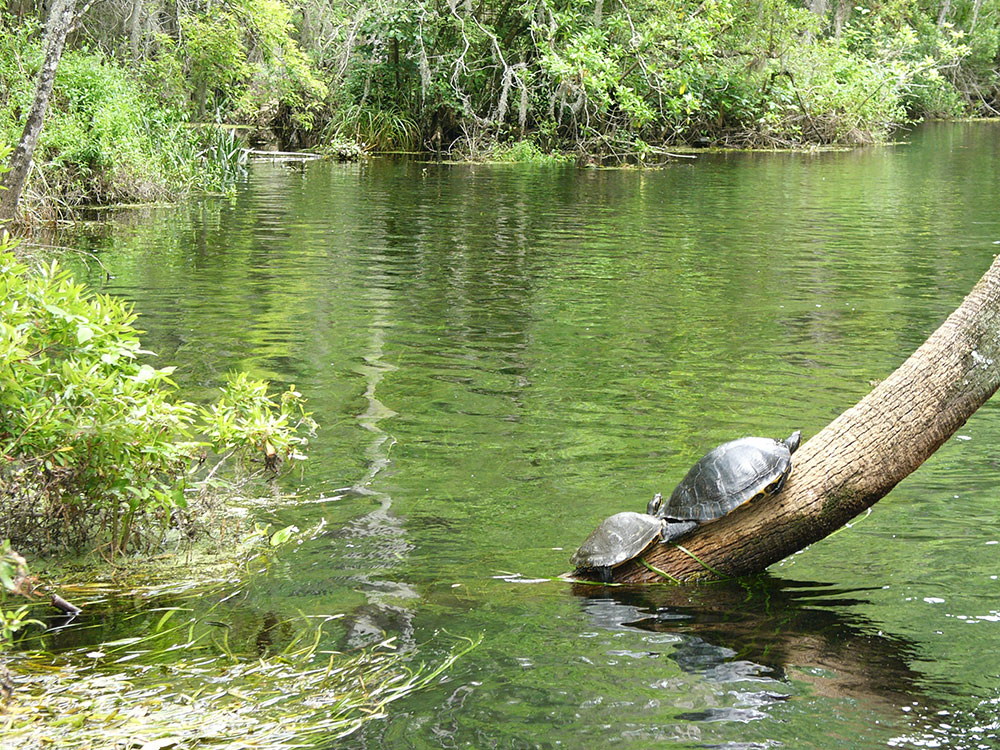
Prehistoric humans
Upper Paleolithic - Paleo-Indians lived at or near the spring over 12,000 years and were descendants of people who crossed into North America from eastern Asia during the Pleistocene. Clovis spear points have been found at Wakulla Springs.
Prehistoric animal life
- American mastodon (Mammut americanum) found at Wakulla.
- Giant ground sloth (Eremotherium laurillardi)
- Saber-toothed tiger (Smilodon populator) found at Wakulla.
- Columbian mammoth (Mammutus columbi)
- Ancient bison (Bison antiquus)
- Equus (Equus scotti) found near Wakulla.
- Short-faced bear (Arctodus simus)
- Miocene dugong (Metaxytherium crataegense) found near Wakulla.
- American lion (Panthera leo atrox) found in Florida.
Animal life today
Found in and around Wakulla Springs are West Indian manatees, white-tailed deer, North American river otters, American alligators, Suwannee River cooters (Pseudemys suwanniensis), snapping turtles, softshell turtles, limpkin, purple gallinules, herons, egrets, bald eagles, anhingas, ospreys, common moorhens, wood ducks, black vultures and turkey vultures.
Beginning in 1938, several of the early Tarzan films including Tarzan's New York Adventure starring Johnny Weissmuller were filmed on location in Wakulla Springs. Other films such as Creature from the Black Lagoon, Return of the Creature, Night Moves, Airport '77 and Joe Panther starring Brian Keith and Ricardo Montalbán were also filmed on location at Wakulla Springs.
Most of the movie history can be traced back to Edward Ball, who purchased the land surrounding Wakulla in 1934. Initially, Wakulla was not a tourist destination, but rather a reclusive resort. This changed when Ball hired a new manager, Newt Perry. Perry is the man who brought publicity to Wakulla Springs. He previously worked at Silver Springs and was established in the movie community during his time there. Then, movie crews followed him to Wakulla Springs.
In 1931, Edward Ball, bought property in Tallahassee, Florida and construction on the Wakulla Springs Lodge started in 1935. Edward Ball hired the architectural firm, Marsh and Saxelbye, who were based in Jacksonville, Florida and known for their Mediterranean style mansions. Initially, the lodge was built as a guest house and was turned into a hotel after his death in 1981 by the Edward Ball Wildlife Foundation.
The lodge is now a hotel with twenty-seven unique rooms that contain genuine antique furniture. There are two rooms called the Edward Ball Room and the Jessie Ball duPont Room that belonged to Edward Ball and his sister, respectively. In the Edward Ball Room, there is the closet that Edward Ball used to hide his supply of Old Forester Bourbon during Prohibition and during the time Wakulla County was a "dry" county.
The lobby of the lodge is home to one of the oldest working Art Deco elevators and the largest known marble bar. The use of Tennessee marble is vast in the lobby, decorating baseboards, floors, stairwells, and desktops. The main staircase is made of marble and ironwork. The ironwork railing was forged onsite and feature local wildlife, some of which are life-size.
In 2002, artisans started working to conserve the ceiling of the lodge, funded in part by the State of Florida, Division of Historical Resources and the Historic Preservation Board. Each picture on the 5,800 square-foot ceiling depicts historic Floridian scenes. The techniques are a combination of many, namely European folk art with Native American influences.
Starting from 1875, glass-bottom boat tours have been an attraction at Wakulla Springs. There is also the River Boat Tour along the Wakulla River. This tour lasts from around 45 minutes to an hour and allows visitors to see an abundance of wildlife.
Edward Ball Wakulla Springs State Park is a 6,000 acre (24 km2) wildlife sanctuary, located south of Tallahassee, is listed on the National Register of Historic Places, and designated a National Natural Landmark. It has three nature trail systems which lead the visitor through pine forests, bald cypress wetlands and hardwood hammock. Hikers, bicyclists and horse riders are welcome. The wildlife found in the forest includes white-tailed deer, wild turkey, and many other bird species, while American alligators, bass, gar, various snakes, and West Indian manatee (during the winter) populate the springs, swamps, and river.
The park draws its name from Edward Ball, the DuPont family financial manager who sold the park lands to the state of Florida.
The park contains Wakulla Springs, one of the world's largest and deepest first-order freshwater springs and an exit point of the Floridan Aquifer. Wakulla Springs' highest outflow has been measured at 860,000 U.S. gallons per minute (54 m3/s). The spring's average flow is about 400,000 US gallons per minute (25 m3/s). The opening of the spring is 180 feet (55 m) down, through which cave divers, especially those of the Woodville Karst Plain Project have explored many miles of its underwater tunnels. The spring gives rise to Wakulla River which flows several miles to the south where it empties into the Gulf of Mexico.
Paleo Indians are known to have camped at the spring 12,000 years ago, where they hunted mastodons, bison, and other ancient animals. The bottom of the spring bowl is littered with bones of mastodons, giant sloths, giant armadillos, and camels. Glass bottom boat tours of the spring and river operate all year.
Fifty-four archaeological sites have been identified in the park. Excavation of part of the Wakulla Springs Lodge site (8WA329) found successive strata of artifacts from 20th century, Seminole, Fort Walton culture, Weeden Island culture, Norwood culture, Archaic, and Paleoindian occupations.
Sally Ward Spring and Cherokee Sink are located within the Park, while Leon Sinks Geological Area is nearby and part of the same karst system.
The Park contains the Wakulla Springs Lodge, which functions as a hotel.
The park has such amenities as birding, boat tours (water contamination makes glass-bottomed boat tours now rare), cabins, hiking, horse trails, picnicking areas, snorkeling, swimming, and wildlife viewing. An interpretive exhibit and concessions are also available
This article uses material from the Wikipedia article "Wakulla Springs", and "Edward Ball Wakulla Springs State Park", which is released under the Creative Commons Attribution-Share-Alike License 3.0
